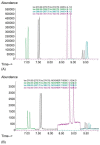Chiral Drug Analysis in Forensic Chemistry: An Overview
- PMID: 29382109
- PMCID: PMC6017579
- DOI: 10.3390/molecules23020262
Chiral Drug Analysis in Forensic Chemistry: An Overview
Abstract
Many substances of forensic interest are chiral and available either as racemates or pure enantiomers. Application of chiral analysis in biological samples can be useful for the determination of legal or illicit drugs consumption or interpretation of unexpected toxicological effects. Chiral substances can also be found in environmental samples and revealed to be useful for determination of community drug usage (sewage epidemiology), identification of illicit drug manufacturing locations, illegal discharge of sewage and in environmental risk assessment. Thus, the purpose of this paper is to provide an overview of the application of chiral analysis in biological and environmental samples and their relevance in the forensic field. Most frequently analytical methods used to quantify the enantiomers are liquid and gas chromatography using both indirect, with enantiomerically pure derivatizing reagents, and direct methods recurring to chiral stationary phases.
Keywords: chiral drugs; enantiomers; forensic chemistry; illicit drugs; pharmaceuticals.
Conflict of interest statement
The authors declare no conflict of interest.
Figures





References
-
- IUPAC Basic Terminology of Stereochemistry. [(accessed on 13 November 2017)]; Available online: https://goldbook.iupac.org/src/src_PAC1996682193.html.
-
- Tiritan M.E., Ribeiro A.R., Fernandes C., Pinto M.M. Chiral Pharmaceuticals. In: Sons J.W., editor. Kirk-Othmer Encyclopedia of Chemical Technology. Wiley; Hoboken, NJ, USA: 2016.
-
- Tsujikawa K., Mikuma T., Kuwayama K., Miyaguchi H., Kanamori T., Iwata Y.T., Inoue H. Profiling of seized methamphetamine putatively synthesized by reductive amination of 1-phenyl-2-propanone. Forensic Toxicol. 2012;30:70–75. doi: 10.1007/s11419-011-0119-0. - DOI
Publication types
MeSH terms
Substances
LinkOut - more resources
Full Text Sources
Other Literature Sources
Medical

